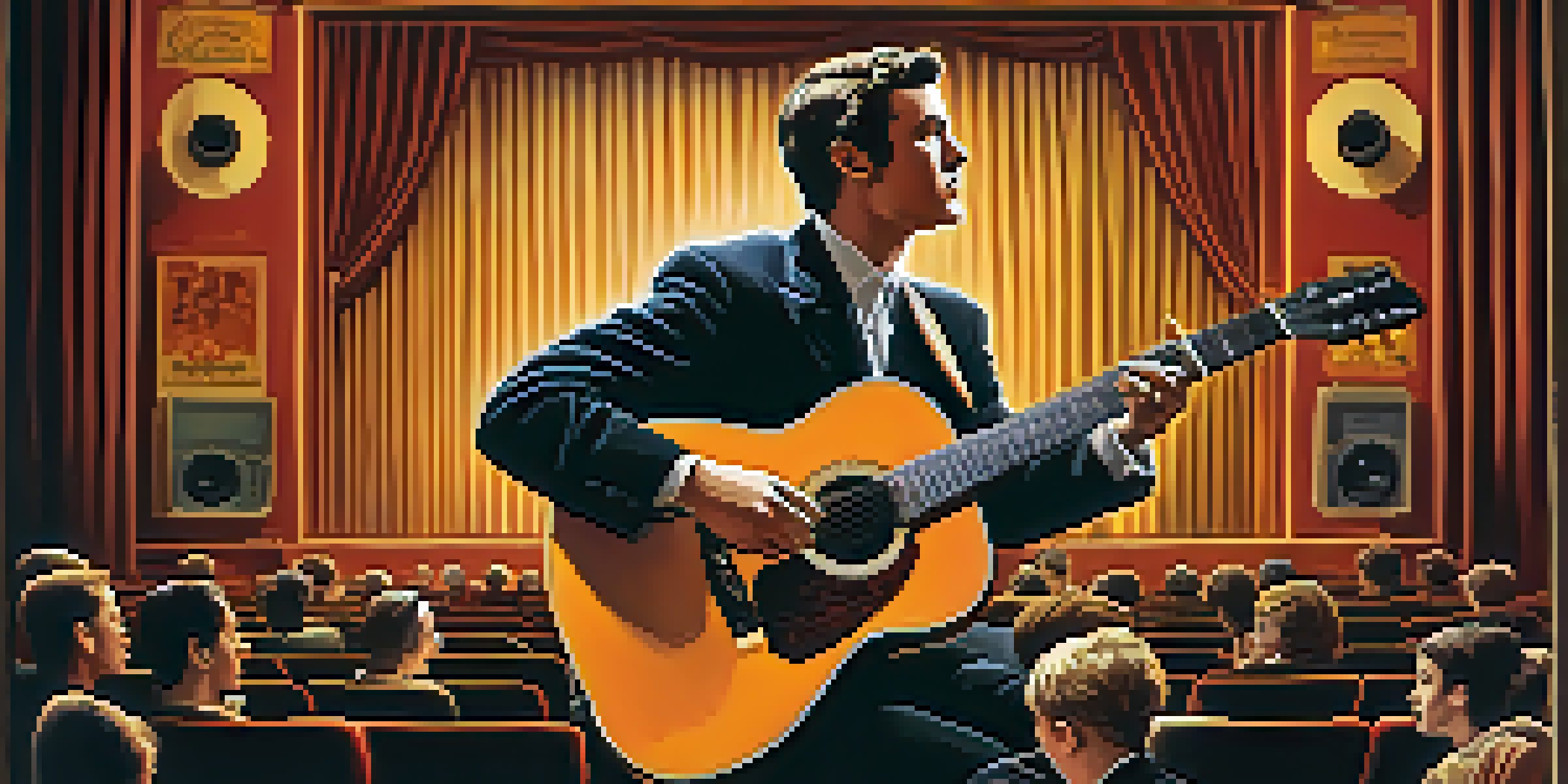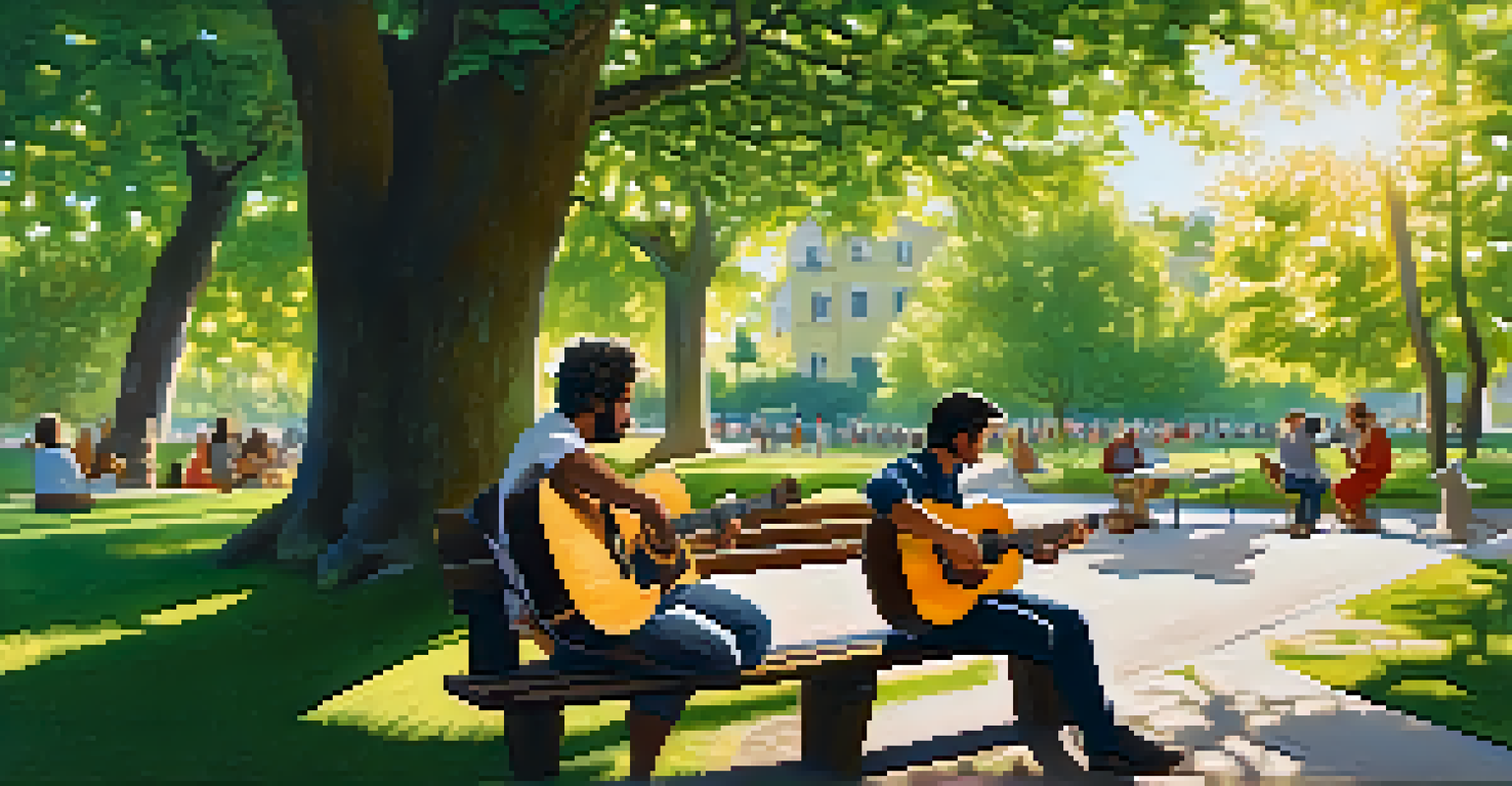The Evolution of Guitar Use in Movie Soundtracks

The Birth of Guitar in Early Film Music
In the early days of cinema, the guitar was often overlooked in favor of orchestral arrangements. However, its unique sound started to capture the attention of composers looking for a more intimate feel. Movies like 'The Birth of a Nation' (1915) began experimenting with guitar, introducing audiences to its rich tonal qualities. This shift marked the beginning of the guitar's journey into mainstream film scoring.
The guitar is a remarkable instrument that can express life’s deepest emotions.
The acoustic guitar, with its warm and inviting sound, found a place in silent film accompaniment. Musicians would often play live in theaters, using the guitar to evoke emotions that complemented the visual storytelling. This practice laid the groundwork for future cinematic soundscapes where the guitar would play a pivotal role.
As films transitioned into the talkies, the guitar's versatility allowed composers to experiment with various styles, from folk to classical. This period saw the instrument gain a foothold in film soundtracks, signifying a budding appreciation for its expressive capabilities.
Guitar and the Rise of Rock in Film Scores
The 1950s and 1960s marked a revolutionary time in movie soundtracks, particularly with the emergence of rock music. Films like 'Psycho' (1960) showcased how the electric guitar could enhance tension and drama, paving the way for its use in horror and thriller genres. The iconic screeching notes from Bernard Herrmann's score became synonymous with suspense, demonstrating the guitar's potential to evoke visceral reactions.

This era also saw the rise of rock 'n' roll films, where the guitar was not just an accompaniment but a central character. Movies like 'A Hard Day's Night' (1964) featured The Beatles, seamlessly integrating their music with the film's narrative. The electric guitar became a symbol of youth and rebellion, capturing the spirit of the time.
Guitar's Rise in Film History
The guitar evolved from an overlooked instrument to a vital component of film soundtracks, enhancing emotional storytelling.
As filmmakers recognized the commercial appeal of rock music, they began to feature guitar-heavy soundtracks more prominently. This not only attracted younger audiences but also set a precedent for how music could drive a film's emotional core.
The Influence of Folk and Acoustic Guitar
Throughout the 1970s and 1980s, the acoustic guitar emerged as a powerful storytelling tool in film soundtracks. Movies like 'The Graduate' (1967) used the gentle strumming of Simon & Garfunkel's music to create a reflective and nostalgic atmosphere. This approach illustrated how the acoustic guitar could convey complex emotions in a subtle yet impactful way.
Music can change the world because it can change people.
The folk revival during this period led to a resurgence of interest in singer-songwriters who utilized the acoustic guitar. Films began to incorporate these songs, allowing the music to act as a narrative device that deepened the audience's connection to the characters. The acoustic guitar's simplicity made it relatable, resonating with viewers on a personal level.
This trend paved the way for soundtracks that balanced orchestral elements with acoustic guitar, creating a rich tapestry of sound. The combination allowed filmmakers to explore deeper themes while maintaining an accessible musical landscape.
The Guitar’s Role in Modern Cinematic Storytelling
In contemporary cinema, the guitar continues to evolve, adapting to new genres and styles. Films like 'Inception' (2010) and 'Interstellar' (2014) showcase how the electric guitar can blend seamlessly with orchestral scores, creating a dynamic sound experience. This fusion enhances the narrative, allowing the music to reflect the film's emotional and thematic complexity.
The rise of independent films has also seen a resurgence of raw, unpolished guitar work. Soundtracks featuring indie artists often highlight the guitar's organic sound, connecting audiences to the film's authenticity. Movies like 'Lady Bird' (2017) use guitar-driven music to convey the characters' struggles and triumphs, making the soundtrack an integral part of the storytelling process.
Cultural Impact of Guitar Music
Iconic guitar riffs in movies have shaped cultural trends and influenced music and fashion, making the guitar a symbol of its era.
Moreover, the guitar's versatility has led to its incorporation into various genres, from action to romance. Its ability to adapt ensures that it remains a relevant and powerful tool in cinematic storytelling.
The Cultural Impact of Guitar in Film Music
The guitar's presence in film music has not only shaped soundtracks but also influenced culture at large. Iconic guitar riffs from movies often become synonymous with specific scenes, forever altering how audiences perceive those moments. Think of the unmistakable notes from 'The Good, the Bad and the Ugly' (1966) that evoke an entire genre of film.
This cultural impact extends beyond just a few memorable notes; it has shaped trends in music and fashion as well. When a guitar-driven soundtrack resonates with audiences, it can spark a wave of interest in that musical style, inspiring everything from fashion choices to emerging artists. The guitar becomes a cultural symbol, reflecting the zeitgeist of the era.
As we continue to see the guitar's influence in film, it’s clear that its role is multifaceted. It serves not just as an instrument, but as a narrative device that bridges the gap between the visual and auditory experience.
The Future of Guitar in Film Soundtracks
Looking ahead, the future of guitar in film soundtracks appears bright and innovative. With advancements in technology, composers are now exploring new ways to integrate guitar sounds into their scores, from digital effects to hybrid instruments. This opens up a world of possibilities for creating unique soundscapes that enhance storytelling.
Moreover, as filmmakers increasingly embrace diversity in their projects, we can expect to see a broader range of guitar styles represented on screen. Genres like flamenco, jazz, and world music are likely to find their way into mainstream cinema, showcasing the guitar's versatility and global appeal. This diversity will enrich the cinematic experience, offering audiences a broader palette of sounds.
Future Innovations in Soundtracks
With technological advancements and diverse styles, the guitar's role in film soundtracks is set to expand and evolve.
Ultimately, the guitar's evolution in film soundtracks reflects the ever-changing landscape of music and storytelling. As long as films continue to be made, the guitar will undoubtedly find its place, adapting and evolving to meet the needs of future narratives.
Conclusion: The Timelessness of Guitar in Cinema
In conclusion, the guitar has undergone a significant evolution in movie soundtracks, from its humble beginnings to its current status as a versatile and impactful instrument. Its ability to evoke emotions, create atmospheres, and drive narratives has solidified its role in cinema. As we've seen, whether through the gentle strumming of an acoustic guitar or the electrifying riffs of rock, it has shaped the way we experience film.
The cultural significance of guitar music in movies cannot be overstated. It has the power to transport us back to our favorite scenes, making them unforgettable and deeply impactful. As filmmakers continue to explore new sounds, the guitar's journey in film is far from over.

As we look to the future, we can anticipate even more innovative uses of the guitar in film soundtracks, ensuring its place in the hearts of audiences and filmmakers alike. The guitar's story in cinema is a testament to its timelessness and versatility in the world of music.